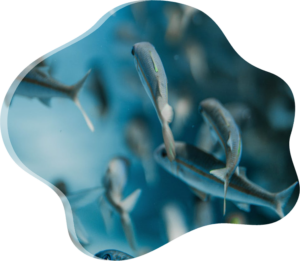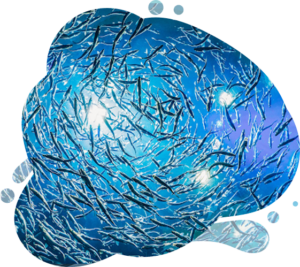Ensuring the health of farmed fish is critical for successful aquaculture operations. Diseases not only threaten fish populations but also impact profitability, food supply, and sustainability. This guide explores the three most common diseases affecting farmed fish and provides actionable strategies for their prevention.
Understanding the Impact of Fish Diseases
Fish diseases are a leading cause of economic losses in aquaculture, with some estimates suggesting they account for up to 20% of total production losses globally (FAO, 2020).

These diseases are triggered by a combination of environmental, nutritional, and biological stressors, such as poor water quality, overcrowding, and inadequate diets.
Fish farmers can reduce disease outbreaks by up to 30% through effective prevention strategies that include optimized nutrition and robust biosecurity measures. This approach not only minimizes fish mortality but also boosts farm productivity and profitability, creating a healthier and more sustainable aquaculture environment. (Source: FAO, 2020)
1. Bacterial Infections: Aeromonas and Vibrio
Bacterial infections, particularly from Aeromonas and Vibrio species, are common and widespread in aquaculture. These infections can lead to symptoms such as ulcers, fin rot, lethargy, and abnormal swimming behavior in affected fish.
Causes
The primary causes of bacterial infections in aquaculture include poor water quality, such as high ammonia levels and low oxygen, which stress the fish. Overcrowding and stress further contribute to weakened fish health. Additionally, compromised immune systems due to inadequate nutrition can make fish more susceptible to infections.
Prevention
To prevent bacterial infections, it is essential to maintain optimal water parameters, including proper pH, temperature, and dissolved oxygen levels. Providing high-quality feed that is rich in essential nutrients helps enhance the fish’s immune system. Routine health checks should be conducted to detect early signs of bacterial infections, and vaccination programs should be implemented where appropriate. Regular disinfection of equipment and tanks also helps minimize the spread of bacteria.
2. Parasitic Diseases: Ichthyophthirius multifiliis (Ich)
Overview
Ich, also known as white spot disease, is caused by the parasite Ichthyophthirius multifiliis. It typically presents as white cysts on the skin, along with erratic swimming behavior and a loss of appetite in affected fish.
Causes
Ich is primarily caused by the introduction of infected fish or the use of contaminated equipment. Poor hygiene in tanks or ponds can also facilitate the spread of this parasite.
Prevention
To prevent Ich, it is important to quarantine new fish for at least two weeks before introducing them to the main stock. Maintaining rigorous tank hygiene and regularly cleaning equipment is also crucial. Providing a nutrient-dense diet can strengthen the fish’s resistance to parasites. In high-risk environments, preventative treatments such as salt baths or approved chemicals can be used.
3. Viral Diseases: Infectious Salmon Anemia (ISA)
Overview
Infectious Salmon Anemia (ISA) is a highly contagious viral disease that primarily affects salmon farms. Symptoms include anemia, pale gills, lethargy, and abnormal swimming patterns in infected fish.
Causes
ISA is transmitted through infected water, equipment, or fish. A lack of stringent biosecurity measures can facilitate the spread of the virus.
Prevention
To prevent ISA, it is essential to enforce strict biosecurity protocols, including controlled access to fish farming areas. Using disease-free certified fingerlings and broodstock is crucial, as is vaccinating fish where vaccines are available. Regular monitoring of fish health and prompt isolation of infected populations also play a key role in preventing outbreaks.
Holistic Disease Prevention Strategies
Improved Nutrition
Providing high-quality fishmeal feed is essential to support the immune health of fish. The feed should include essential nutrients such as omega-3 fatty acids, vitamins (A, D, E), and trace minerals. A well-balanced diet can reduce disease susceptibility by up to 30%.
Water Quality Management
Monitoring critical parameters like ammonia, nitrites, and pH is essential to maintain water quality. Regular water exchanges and the use of filtration systems help ensure cleanliness. It is also important to avoid overfeeding, which can pollute the water and encourage the proliferation of diseases.
Hygiene and Biosecurity
Regularly disinfecting tools, nets, and tanks is crucial to preventing disease spread. Implementing footbaths and hand sanitizing stations for personnel, as well as using separate equipment for different tanks, helps avoid cross-contamination.
Routine Health Monitoring
Training staff to recognize early symptoms of diseases is key in preventing outbreaks. Conducting regular sampling and laboratory tests to identify pathogens ensures timely intervention. Establishing a protocol for immediate response to outbreaks can help control the spread of diseases effectively.
Why Prevention Is Better Than Cure
Preventing diseases in aquaculture is not only more cost-effective but also more sustainable in the long run compared to treating outbreaks. Effective disease management strategies help improve overall survival rates, ensuring that fish remain healthy and productive.
By focusing on prevention, aquaculture operations can reduce the reliance on antibiotics, which is critical in combating antibiotic resistance. This is particularly important as excessive use of antibiotics can contribute to the development of resistant strains of pathogens, making future treatments less effective.
Additionally, prevention helps lower operational costs by minimizing fish mortality, reducing the need for costly treatments, and improving overall efficiency. Healthy fish are also of higher quality, which enhances the marketability of the product. Consumers increasingly demand responsibly farmed, disease-free fish, and maintaining a preventative approach ensures that aquaculture products meet these standards, thus improving marketability and consumer trust.
Conclusion
Bacterial infections, parasitic diseases, and viral outbreaks are the three most common threats to farmed fish health. By focusing on prevention through high-quality nutrition, water quality management, and biosecurity measures, aquaculture operators can mitigate risks and ensure sustainable operations. Investing in these strategies promotes healthier fish, higher yields, and a more profitable farming venture.
FAQ
Q: What is the most effective way to prevent fish diseases?
A: A combination of high-quality nutrition, excellent water quality, and strict biosecurity measures is the most effective approach.
Q: Can diet alone prevent fish diseases?
A: While diet plays a significant role in boosting immunity, it should be complemented with proper hygiene and monitoring.
Q: How do bacterial infections typically spread in aquaculture?
A: They spread through poor water quality, contaminated equipment, and stress caused by overcrowding.
Q: Why is prevention better than cure?
A: Preventing diseases is more cost-effective and sustainable than treating outbreaks. Disease management strategies not only improve survival rates but also reduce reliance on antibiotics, lower operational costs by minimizing fish mortality and enhance product quality and marketability.
By adopting these best practices, aquaculture businesses can achieve long-term success while maintaining the health and sustainability of their fish populations.
